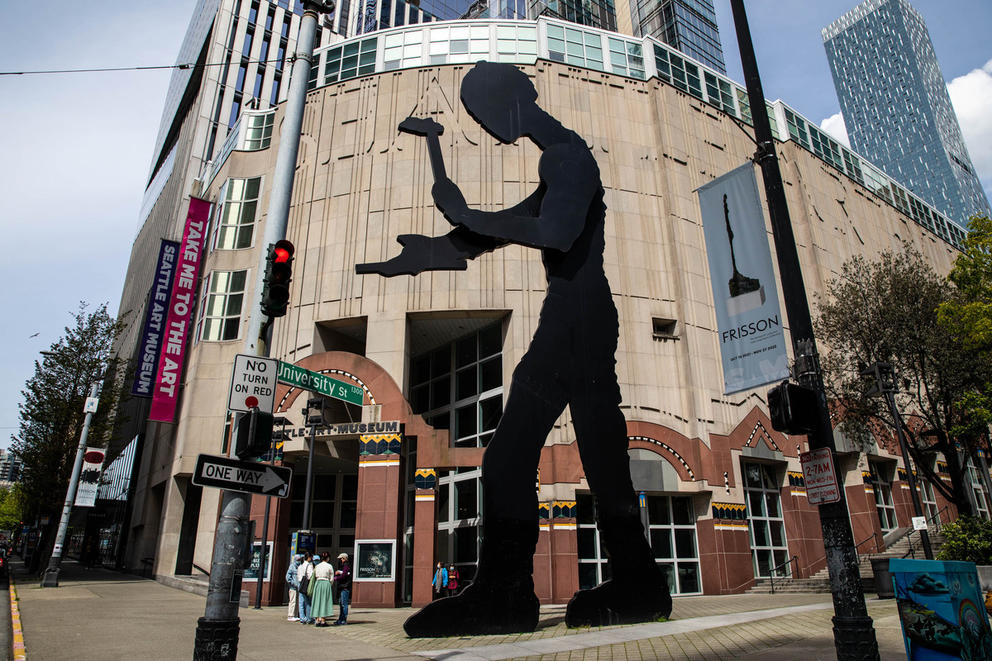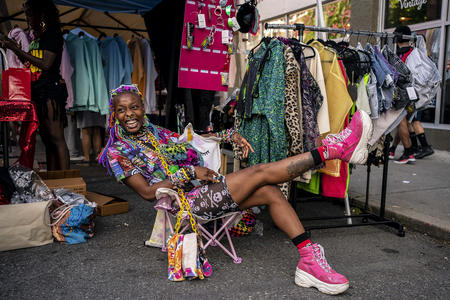But to Anderson, SAM’s showcasing of this work rings hollow. “I want people to pay attention to the hypocrisy and the disconnect between the art we show and the way workers are treated,” they say.
Anderson is part of a group of Seattle Art Museum security guards, aka visitor service officers, who are trying to form a union in a push to improve working conditions at the museum’s downtown and Volunteer Park locations. The effort comes amid a growing wave of union organizing in U.S. museums and a flurry of high-profile union votes locally and nationally.
At SAM, eligible union employees will cast their vote via mail-in ballots from May 10 to 31. If successful, the Seattle Art Museum Visitor Service Officers Union would include roughly 65 full-time and part-time museum security officers and dispatchers — many of them also artists — who work at the Seattle Art Museum and the Seattle Asian Art Museum. The organizers say they want more of a voice in workplace decisions and in shift scheduling, as well as a seniority pay system, higher wages to account for Seattle’s cost of living and reinstatement of payments to their retirement plans, which were cut earlier in the pandemic.
“There are a lot of good things about our job,” Anderson says. “Good things that we know can be taken away at a moment's notice — that did happen throughout the pandemic.”
In late June 2020, Seattle Art Museum leadership took several measures to stop the revenue bleeding, as the museum remained closed through the early days of the pandemic, including instituting pay cuts, suspending contributions to employee retirement plans and furloughing more than 70 employees (primarily part-time workers; SAM declined to share how many of them were visitor service offficers). The museum’s top earners (some of whom make more than $100,000 a year, according to public documents) also took pay cuts during that time — 10% in March 2020, an additional 5% in July 2020. Those, and all other pay cuts, were restored in the first quarter of 2021, but employer payments to retirement plans have not resumed.
“When the museum chose to [restore the pandemic pay cut to] those in the highest-earning positions … but not return frontline workers' retirement benefits, it became clear that our voices were not prioritized and that any of our benefits could be changed at any time — and that we could not do anything about it,” visitor service officers union organizer Josh Davis said in an email. He noted that a lack of employee say in workplace safety issues during the pandemic — in particular, the lack of recourse to deal with patrons who refused to wear masks at various instances — amplified this feeling of powerlessness.
“We knew at this point we needed to come together to ask for a contract that would guarantee us the continuation of our benefits and put contractual measures into place so that our concerns about workplace safety would be taken seriously,” he added.
A Seattle Art Museum representative said in a statement that reinstating employer contributions to the retirement plan remains a “top priority.” “We hope to determine in the next few months whether we are able to reinstate … this benefit in the next year,” the statement read.
The museum also said it had been as transparent as possible and proactive in its communications throughout the pandemic, noting that “feedback was reviewed during weekly and biweekly COVID Recovery Task Force and Operations meetings, respectively, and was responded to swiftly with action.” SAM said that, for example, it is continuing to limit attendance on Free First Thursdays, the museum’s busiest day, in response to staff feedback.
But organizers say they want a seat at the table through collective bargaining to make sure their input is considered. Bargaining would begin after a successful May vote. If a majority approves the union, the visitor service officers would become the second museum-guard union to form in Seattle, after the security guards at the Frye Art Museum, who voted to form a union in 2019.
They would also join the recent wave of workers who have voted to form collective bargaining units in other U.S. museums, including the New Museum, Guggenheim and Whitney in New York, as well as The Museum of Fine Arts in Boston, the Philadelphia Museum of Art and the Portland Art Museum, among others. In 2020 and 2021, union membership at museums reached its highest level since 2013, roughly 13%, data from the Union Membership and Coverage Database shows.
Visitor service officer union organizers at SAM, inspired by the Frye Art Museum guards and book mongers at Seattle’s flagship Elliott Bay Books (the latter of whom finished negotiating their first contract last year) and other union efforts around the country, started talking about unionizing about a year ago. It’s been a rocky road since then, they say.
According to Davis, Anderson and organizer Aselya Keyes, the museum has pushed back on the union and engaged in union-busting through foot-dragging via legal procedures, misleading all-staff emails attacking the character of organizers and, most recently, the firing of Keyes, who says she was let go because of her active role with the union. The museum unequivocally denies the allegations and says Keyes’ firing followed an internal investigation into allegations of workplace misconduct, but declined to share further details. The museum also says it has not retaliated or pushed back but “has been and continues to be neutral about whether its security guards are represented by a union.”
Organizers disagree. They also say that management has tried to dilute the union by instituting a departmentwide restructuring that they say negatively affects pro-union individuals. (SAM maintains this restructuring was meant to help with staff retention and provide more advancement opportunities.) They also think an across-the-board pay raise — SAM gave visitor service officers a raise in December of 2021, upping their starting hourly wages from $17.69 to $20.44 an hour — while appreciated, was meant to dissuade people from wanting a union.
The museum says that’s “absolutely false,” and that the raises were part of an organization-wide compensation analysis and update that began in July of 2021, “long before any union petition was filed,” the spokesperson said.
As of early this month, union organizers have filed various unfair labor practice charges with the National Labor Relations Board, alleging retaliation, surveillance, threats and more. These charges are currently still under investigation. (A SAM representative said in a statement it unequivocally denies the allegations but declined to otherwise comment on pending litigation.)
This makes the visitor service officers union exemplary of a broader trend: The number of filings for union elections and unfair labor practice charges has risen at nonprofits and corporations across the U.S. in the past six months, representing a broader shift in how workers are trying to earn more of a say in their workplaces.
While nationally the number of wage and salary workers belonging to unions has sunk to historic lows in recent years, in the last six months the National Labor Relations Board has recorded a 64% increase in workers filing for union elections, compared with the same period the year before, public data shows. In Washington state, those numbers, while small, have increased by 86%, from 37 to 69. According to a recent Gallup poll, the general public’s approval of labor unions is at its highest point since 1965.
Buoyed by high-profile union efforts at Amazon warehouses and Starbucks locations, as well as by the pandemic’s unforgiving UV-light on the labor market’s deep-running inequities, a union revival may be afoot.
The impact on the Pacific Northwest’s broader cultural scene remains to be seen, but several inklings of this union movement have popped up recently. Oregon’s Shakespeare Festival Association, as well as workers at a Portland comic book store, voted in favor of unions earlier this year. In Seattle, hourly SIFF cinema workers, although not unionized, recently staged a walkout at the tail-end of the Seattle International Film Festival, to protest a lack of transparency about their hours and the future of their employment.
The pandemic has accelerated a trend already in motion across all sectors, including the arts, says Sarah E. Dempsey, a University of North Carolina Chapel Hill communications professor who specializes in nonprofits, organizational communication and feminist theories of work. “The pandemic in many ways peeled back the curtain on the outsized power that employers wield over workers,” she says.
A surge of online organizing and the advent of popular social media accounts, such as Change The Museum, have further emboldened workers to speak out about inequities, discrimination and working conditions in museums across the U.S.
The sector is also experiencing a change in foundational philosophy. In recent years, many art and nonprofit workers, Dempsey says, have started to push back on the idea that people work in the arts (or other fields that benefit the public, like teaching) because they love it, not to get paid. She says arts workers and others have also become increasingly willing to call out the disparities of the art world, where politically radical artworks can end up being traded for thousands or millions of dollars. Often, these artworks end up in well-endowed museums, where they’re guarded by staff that makes a fraction of top museum officials’ pay.
“The problem is the disconnect between these performances of doing better, and the actual practices … [of making] specific changes in terms of hiring, retention, payment, compensation, worker treatment, health and safety — all those things that require action,” she says. “The discourse and identity work that our arts institutions and museums are doing, if that’s not matched by substantive changes, then that's a real problem. They face a problem of legitimacy.”
Davis, of the union effort at SAM, also noted this disconnect. The visitor service officer group is mostly made up of working-class artists, musicians and creatives (“You should see our locker room, it is packed to the brim with employee artwork,” he said), many of whom love working at the art museum, he wrote in an email.
“The museum has in its mission statement a commitment to pursuing equity and to supporting art,” Davis continued. “... By asking the museum to collectively bargain with our union, we are just asking it to pursue its mission statement of equity as it applies to its frontline security employees as well.”
Get the latest in local arts and culture
This weekly newsletter brings arts news and cultural events straight to your inbox.






